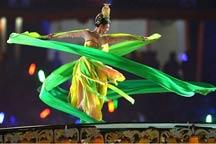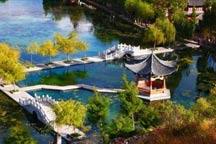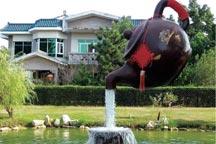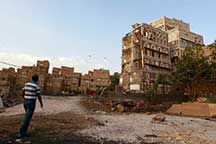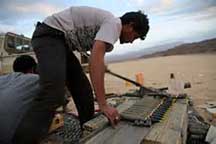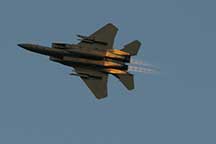Mount Songshan is located in Dengfeng County in Henan Province in central China. With Taishi and Shaoshi peaks, this very famous mountain in the Central Plains towers magnificently, with the Yellow River to the north and the Yingshui River to the south.
The God of Mount Songshan was given the title “Middle Heaven King” by Empress Wu Zetian of the Tang Dynasty (618-907). Unlike the ancient emperors, who always conferred titles on Mount Taishan, Empress Wu Zetian visited Mount Songshan and gave it the title of “Divine Mountain”. She also renamed the counties in which Mount Songshan was located, changing the name of Songyang County to Dengfeng (conferring titles) and the name of Yangcheng to Gaocheng (success) to indicate that she had successfully conferred a title on Mount Songshan and had the country under her control. In 1982, a roll of gold strips was found in a crack between rocks on the top of Junji Peak. It was shown to have been thrown by Empress Wu Zetian when she was worshiping the God of Mount Songshan. At 36.3 cm long and weighing 247 g, this valuable cultural relic is inscribed with 63 characters written in double strokes.
According to Daoism (Taoism), among the abodes of immortals and ideal places for self-cultivation, Mount Songshan is the sixth of the 36 Lesser Grotto Heavens. Among the many remnants of Daoism, the earliest was left by Crown Prince Jin, son of King Ling of Zhou (r.571-545 BC), who was taken to Mount Songshan by a Daoist called Master Fuqiu. Today, there is Fuqiu Peak in the eastern part of Mount Songshan, and Prince Jin Peak in the western part. The Sui (581-618) and Tang dynasties saw Daoism flourish on Mount Songshan. Many noted Daoists lived and cultivated themselves there, such as Pan Shizheng, Sima Chengzhen, and Li Hanguang, founding masters of the High Purity sect. Daoism on Mount Songshan gradually declined during the Ming and Qing dynasties.
There used to be many Daoist palaces and monasteries on Mount Songshan but today only Zhongyue Temple still remains.
Zhongyue Temple is located at the southern foothills of Mount Songshan’s Taishi Peak. It was first built in the Qin Dynasty (221-206 BC) and originally known as Taishi Temple. Today’s temple buildings, covering an area of more than 100,000 sq. m, were rebuilt during Emperor Qianlong’s reign in the Qing Dynasty (1644-1911). The axis, a flagged pathway 700 m long, extends from the front Zhonghua Gate in the south to the rear gate of Yushu Tower in the north. The east and west wings of the temple consist of the buildings, each having a small separate courtyard. The temple has a reputation as a home of relics with 330 old cypresses, 100 stone steles, sacred ding tripods, and iron warriors.
To the rear of Tianzhong Pavilion is a cypress grove arranged in an orderly fashion. In the courtyard inside Chongsheng Gate stand two quadrangular pavilions, one on the east side and the other on the west. The western pavilion houses a stele with no inscription, so it is called Inscriptionless Stele Pavilion. The eastern pavilion, called Ancient Divine Storehouse Pavilion, is surrounded by four august-looking iron warriors, each more than 2.5 m in height. It is said that they are monuments depicting the four Daoists who joined the army to fight against Jin invaders during the Song Dynasty (960-1279). The story goes that, during the last years of the Northern Song Dynasty, the army of the Kingdom of Jin invaded from the north. On hearing the news, four strapping Daoists from Zhongyue Temple could not concentrate on their self-cultivation. They left the temple and joined the troops of General Yue Fei. They distinguished themselves on the battlefield and laid down their lives in battle.
North from Tiantai Terrace is a walkway shaped like a ribbon hanging down and with carvings of a coiled dragon, two dragons playing with a pearl, and a flock of cranes playing among lotus flowers. This leads to steps up to a three-m-high stone platform before the visitor reaches Zhongyue Temple’s main hall, Junji Hall. It is the largest building on Mount Songshan. The hall is nine bays across and five bays deep. It has a yellow double-eaved glazed-tile roof with a Chinese hipped roof on top of that. The rafters, bucket arches, beams, crossbeams and ceiling are all covered with Hexi palatial architecture paintings of the highest class from the Qing Dynasty. The ceiling is decorated with a flying dragon, and the floor is paved with polished dark blue flagstones. A statue of the Great Emperor of the Sacred Mountain of the Center stands five m tall at the shrine, flanked by statues of his valiant generals Fang Bi and Fang Xiang holding battle-axes. In the 14th year of the Ming Emperor Chongzhen’s reign (1641), the hall was destroyed in a fire. It was rebuilt in the 10th year of the Qing Emperor Shunzhi’s reign (1653). In 1941, it was damaged as a result of bombings by Japanese invaders. Since the founding of the People’s Republic in 1949, the hall has been repaired many times.
At the southern foot of Mount Songshan, there are several palaces where emperors could live during temporary stays there. They include Huanggai (Yellow Canopy) Pavilion, which gives a full view of the tranquil and beautiful Zhongyue Temple.









